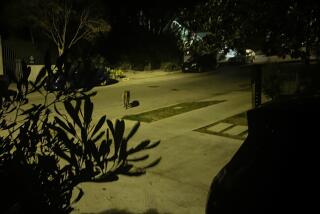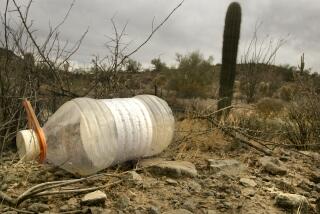A Friend for the Coldblooded
- Share via
WHITE WATER CANYON, Calif. — The driver of the SUV slammed on his brakes after his high beams caught a large orange and red lizard in the middle of the road.
The “lizard” turned out to be a plastic decoy set by state Dept. of Fish and Game Warden Kyle Chang to lure illegal reptile rustlers. Chang questioned the driver, Robert Sobolewski, who, it turned out, had a license to hunt for such animals as the baby sidewinder sitting in a glass container on the back seat of his SUV.
“It was the first of several stops that Chang, one of the few wardens in the state assigned to reptile enforcement, made during a crackdown Friday night on poachers in this 3-mile-long desert wash framed by towering sandstone cliffs about 120 miles east of Los Angeles.
In the world of reptile hunting, White Water Canyon is regarded as an oasis. Spanning several transition zones, including sandy desert, boulder fields, grasslands and forests, it teems with a variety of snakes and lizards that tend to congregate on its narrow two-lane road at night.
That makes them easy pickings for collectors who cruise for hours in hopes of bagging snakes such as the spotted leaf-nosed, the glossy, the Western shovel-nosed, the Western Blind, the Lyre, the king snake, the gopher, the rattlesnake and the Western banded gecko.
Of particular interest to connoisseurs are so-called “White Water rosy boa constrictors,” which are prized because of their docile nature and vibrant orange and pink hues.
Keeping the canyon’s wildlife safe from irresponsible collectors would require a level of security that at this point is elusive, given the state budget crisis. But by their occasional presence, Chang and the decoy he calls Bubba have become deterrents against those who would exploit wild reptiles for personal gain.
Setting the plastic back on the road, Chang said, “Maybe we can save a reptile or two tonight.”
Then he got back into his green truck crammed with radios, shotguns and survival gear, and drove behind a hedge of creosote bushes. Hidden from view, he switched off the ignition, turned off the lights and waited.
The man and his decoy are an unlikely duo. Chang, 32, is a husky officer with an easy smile who never grew out of his boyhood love of snakes, frogs, toads and salamanders. Usually, his work days are spent enforcing hunting and fishing regulations in and around the Hemet area.
Bubba is his nephew’s toy. “I just slapped some paint on it to make it look sort of like a banded gecko,” he said with a laugh. “Works every time.”
A few minutes later, a truck exited Interstate 10 about a mile away, and then headed toward this Coachella Valley canyon sandwiched between Mt. San Jacinto on the south and the San Bernardino Mountains on the north.
The truck slowed to a crawl and flipped on its bright lights. No sooner had it screeched to a halt on a decoy down the road -- this one a small rubber snake -- than the warden fired up his truck and roared up to the scene with law enforcement lights flashing.
“Got licenses?” Chang asked.
“Sure,” replied Jason Van Kirk, 33, and Shawn Silva, 43, who were at once alarmed and delighted to finally cross paths with the law enforcement officer they’d heard so much about. “You’re something of a legend around here,” Silva told Chang.
However, as collectors who prided themselves on, as Van Kirk put it, “being able to tell a Popsicle stick or a fan belt from a snake at 40 miles per hour,” they also were a little embarrassed.
State law allows certain reptiles to be taken from the wild but they may not be sold, and each has a bag limit, the same as fish. In fact, a freshwater fishing license is required.
The problem for authorities is trying to distinguish wild snakes or lizards from captive-bred ones. State fish and game authorities suspect that many wild reptiles are “laundered” through legitimate breeders or dealers before being sold to collectors, or shipped out of state.
Three months ago, Chang cited a White Water collector who failed to mention that he had 10 desert night lizards inside an ice-chest. In a separate case earlier this year, Chang confiscated a wild gopher snake from a Rancho Cucamonga pet shop.
Once taken out of their habitat, snakes and lizards cannot be released back into the wilds since they may have picked up infectious diseases. For that reason, Chang donates the animals he seizes to local zoos and colleges.
The 10 desert night lizards will be given to Dr. Glenn Stewart, a professor of zoology at Cal Poly Pomona, and a strong supporter of Chang’s work in the field.
“I’ve been concerned about over-collecting for a long time because it really can deplete populations,” Stewart said.
Chang could not agree more. Nonetheless, as someone who still gets a kick out of crossing paths with a snake in the wild, he usually lets people off with only a verbal warning.
It was after midnight when Chang ended his stakeout, tossed Bubba into the truck and headed home. The fact that none of the half dozen people he encountered had been arrested, or even cited, did not seem to bother him in the least.
“I’m fighting the 10 out of 100 people who take everything they find on the road, from snakes to scorpions,” he said. “Beyond that, this is one of the most fun patrols I do.”
More to Read
Sign up for Essential California
The most important California stories and recommendations in your inbox every morning.
You may occasionally receive promotional content from the Los Angeles Times.











